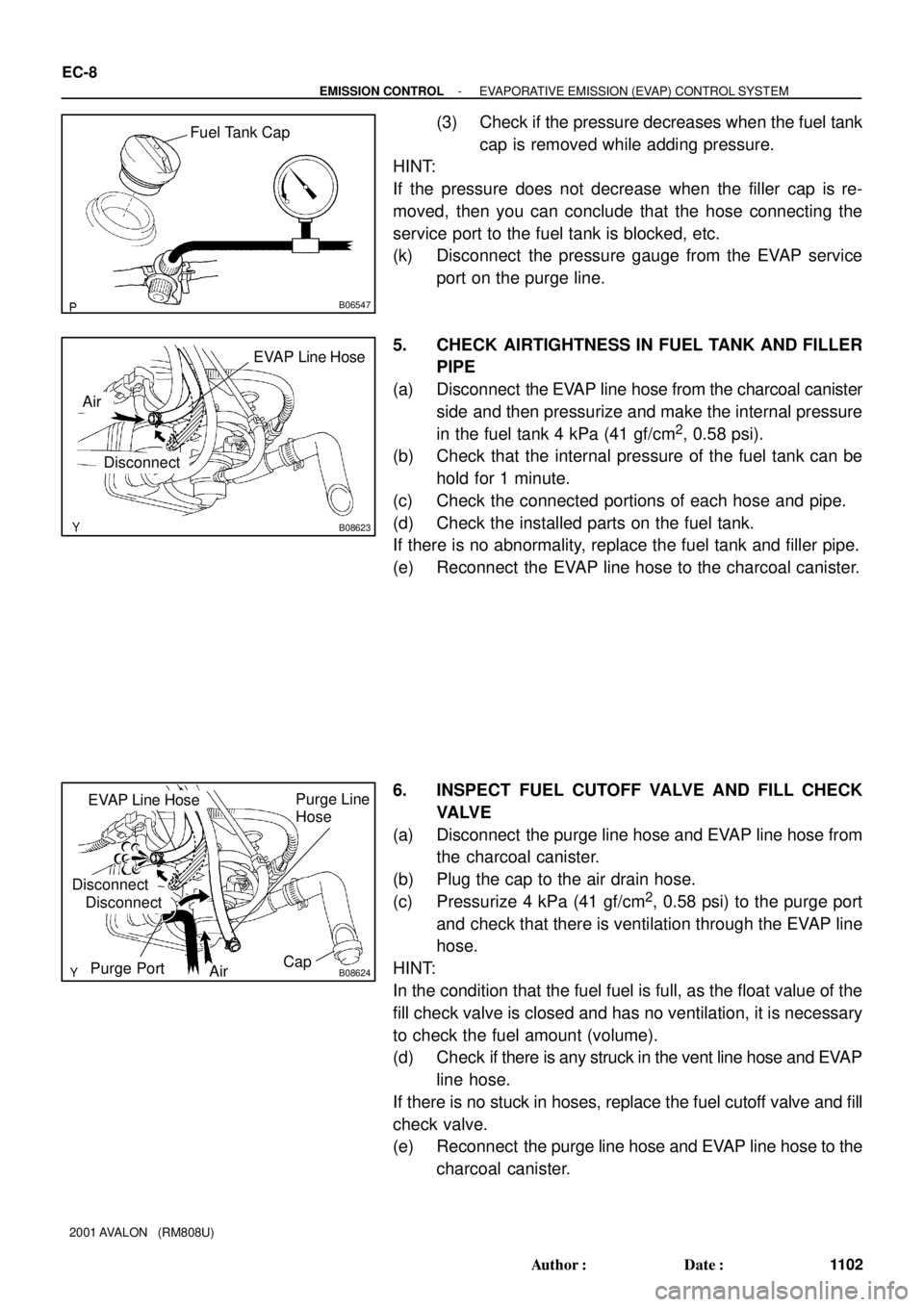Page 1203 of 1897
H02750
Airbag Sensor Assembly Front Airbag Sensor (LH)
+SL
-SL C615
26 2
1 +SL
IF2
-SL21
C6 BR BRW-R W-R
IF2
- DIAGNOSTICSSUPPLEMENTAL RESTRAINT SYSTEM
DI-467
623 Author�: Date�:
2001 AVALON (RM808U)
DTC B1158/B1159/16 Front Airbag Sensor (LH) Malfunction
CIRCUIT DESCRIPTION
The front airbag sensor (LH) circuit consists of the airbag sensor assembly and front airbag sensor (LH).
For details of the function of each component, see OPERATION on page RS-3.
DTC B1158/B1159/16 is recorded when malfunction is detected in the front airbag sensor (LH) circuit.
DTC No.DTC Detecting ConditionTrouble Area
B1158/B1159/16�Front airbag sensor (LH) malfunction
�Front airbag sensor (LH)
�Wire harness
�Airbag sensor assembly
�Engine room main wire harness
WIRING DIAGRAM
DI6N3-01
Page 1224 of 1897
DI15Z-10
Supplemental Restraint System Check Sheet
Date Problem Occurred
Customer 's Name
Registration No.
Registration Year
Frame No.
Odometer Reading
Weather
Temperature
Vehicle Operation
Road Conditions
Details Of Problem
Vehicle Inspection and Repair
History Prior to Occurrence of
Malfunction (Including Supple-
mental Restraint System)
Diagnosis System Inspection
SRS Warning Light
Inspection
DTC Inspection1st Time
2nd Time
1st Time
2nd TimeInspector 's
Name
Fine Cloudy Rainy Snowy Other
Approx.
Starting Idling
Driving [ Constant speed Acceleration Deceleration
Other ]
Remains ON Sometimes Lights Up Does Not Light Up
Remains ON Sometimes Lights Up
Does Not Light Up
Normal Code Malfunction Code
Normal Code Malfunction Code[ Code. ]
[ Code. ]km
Miles //
//
// Date Vehicle Brought In
DI-348
- DIAGNOSTICSSUPPLEMENTAL RESTRAINT SYSTEM
504 Author�: Date�:
2001 AVALON (RM808U)
CUSTOMER PROBLEM ANALYSIS CHECK
Page 1243 of 1897
I00298
1 (+)
2 (-)
DI-548
- DIAGNOSTICSTHEFT DETERRENT SYSTEM
704 Author�: Date�:
2001 AVALON (RM808U)
INSPECTION PROCEDURE
1 Check engine hood courtesy switch.
PREPARATION:
(a) Remove engine hood lock assembly.
(b) Disconnect engine hood courtesy switch connector.
CHECK:
Check continuity between terminals 1 and 2 when engine hood
lock is locked and unlocked.
OK:
Engine hood lockTester connectionSpecified condition
LOCK-No continuity
UNLOCK1 - 2Continuity
NG Replace engine hood courtesy switch.
OK
2 Check harness and connector between theft deterrent ECU and switch, switch
and body ground (See page IN-30).
NG Repair or replace harness or connector.
OK
Check and replace theft deterrent ECU (See
page IN-30).
Page 1249 of 1897
I01663
OFF
ON
1 2
3 4
- DIAGNOSTICSTHEFT DETERRENT SYSTEM
DI-543
699 Author�: Date�:
2001 AVALON (RM808U)
INSPECTION PROCEDURE
1 Check key unlock warning switch.
PREPARATION:
Disconnect key unlock warning switch connector.
CHECK:
Check continuity between terminal 1 and 2 of key unlock warn-
ing switch connector, when the key is inserted to the key cylin-
der or removed.
OK:
Switch positionTester connectionSpecified condition
ON (Key inserted)1 - 2Continuity
OFF (Key removed)-No continuity
NG Replace key unlock warning switch.
OK
2 Check harness and connectors between ECU and key unlock warning switch,
key unlock warning switch and body ground (See page IN-30).
NG Repair or replace harness or connector.
OK
Check and replace theft deterrent ECU.*1
*1: When there is a malfunction that the theft deterrent system cannot be set, proceed to the next numbered
circuit inspection shown in problem symptom table (See page DI-531).
Page 1251 of 1897

AB0119
I11584
I11584
ON
1
I11585
2
1
- DIAGNOSTICSTHEFT DETERRENT SYSTEM
DI-545
701 Author�: Date�:
2001 AVALON (RM808U)
INSPECTION PROCEDURE
1 Check voltage between terminal 1 of luggage compartment door key lock and
unlock switch connector and body ground.
PREPARATION:
(a) Remove luggage compartment door trim.
(b) Turn ignition switch ON.
CHECK:
Measure voltage between terminal 1 of luggage compartment
door key lock and unlock switch connector and body ground,
when the key is turned to the unlock side and not turned respec-
tively.
OK:
Key operationVoltage
Turned to the unlock side0 V
Not turnedBattery positive voltage
OK Check and replace theft deterrent ECU.*1
NG
2 Check luggage compartment door key lock and unlock switch.
PREPARATION:
Disconnect luggage compartment door key lock and unlock
switch connector.
CHECK:
Check continuity between terminals 1 and 2, when the key is
turned to the unlock side and not turned respectively.
OK:
Key operationTester connectionSpecified condition
Turned to unlock1 - 2Continuity
Not turned-No continuity
NG Repair or replace luggage compartment door
key lock and unlock switch.
OK
Page 1275 of 1897

B06547
Fuel Tank Cap
B08623
Air
Disconnect
EVAP Line Hose
B08624Air
Disconnect
Cap
Disconnect
EVAP Line HosePurge Line
Hose
Purge Port
EC-8
- EMISSION CONTROLEVAPORATIVE EMISSION (EVAP) CONTROL SYSTEM
1102 Author�: Date�:
2001 AVALON (RM808U)
(3) Check if the pressure decreases when the fuel tank
cap is removed while adding pressure.
HINT:
If the pressure does not decrease when the filler cap is re-
moved, then you can conclude that the hose connecting the
service port to the fuel tank is blocked, etc.
(k) Disconnect the pressure gauge from the EVAP service
port on the purge line.
5. CHECK AIRTIGHTNESS IN FUEL TANK AND FILLER
PIPE
(a) Disconnect the EVAP line hose from the charcoal canister
side and then pressurize and make the internal pressure
in the fuel tank 4 kPa (41 gf/cm
2, 0.58 psi).
(b) Check that the internal pressure of the fuel tank can be
hold for 1 minute.
(c) Check the connected portions of each hose and pipe.
(d) Check the installed parts on the fuel tank.
If there is no abnormality, replace the fuel tank and filler pipe.
(e) Reconnect the EVAP line hose to the charcoal canister.
6. INSPECT FUEL CUTOFF VALVE AND FILL CHECK
VA LV E
(a) Disconnect the purge line hose and EVAP line hose from
the charcoal canister.
(b) Plug the cap to the air drain hose.
(c) Pressurize 4 kPa (41 gf/cm
2, 0.58 psi) to the purge port
and check that there is ventilation through the EVAP line
hose.
HINT:
In the condition that the fuel fuel is full, as the float value of the
fill check valve is closed and has no ventilation, it is necessary
to check the fuel amount (volume).
(d) Check if there is any struck in the vent line hose and EVAP
line hose.
If there is no stuck in hoses, replace the fuel cutoff valve and fill
check valve.
(e) Reconnect the purge line hose and EVAP line hose to the
charcoal canister.
Page 1286 of 1897
EM0CB-03
A10537
CO/HC Meter
- ENGINE MECHANICALCO/HC
EM-1
985 Author�: Date�:
2001 AVALON (RM808U)
CO/HC
INSPECTION
HINT:
This check is used only to determine whether or not the idle CO/
HC complies with regulations.
1. INITIAL CONDITIONS
(a) Engine at normal operating temperature
(b) Air cleaner installed
(c) All pipes and hoses of air induction system connected
(d) All accessories switched OFF
(e) All vacuum lines properly connected
(f) SFI system wiring connectors fully plugged
(g) Ignition timing check correctly
(h) Transmission in neutral position
(i) Tachometer and CO/HC meter calibrated by hand
2. START ENGINE
3. RACE ENGINE AT 2,500 RPM FOR APPROX. 180 SE-
CONDS
4. INSERT CO/HC METER TESTING PROBE AT LEAST
40 cm (1.3 ft) INTO TAILPIPE DURING IDLING
5. IMMEDIATELY CHECK CO/HC CONCENTRATION AT
IDLE AND/OR 2,500 RPM
HINT:
When doing the 2 mode (2,500 rpm and idle) test, follow the
measurement order prescribed by the applicable local regula-
tions.
Page 1332 of 1897

A05241
A05739
A05705
- ENGINE MECHANICALCYLINDER HEAD
EM-49
1033 Author�: Date�:
2001 AVALON (RM808U)
(c) Remove the camshafts.
19. INSPECT CAMSHAFT GEAR BACKLASH
(a) Install the camshafts without installing the exhaust cam
sub-gear (See page EM-59).
(b) Using a dial indicator, measure the backlash.
Standard backlash:
0.020 - 0.200 mm (0.0008 - 0.0079 in.)
Maximum backlash: 0.30 mm (0.0188 in.)
If the backlash is greater then maximum, replace the cam-
shafts.
(c) Remove the camshafts.
20. INSPECT CAMSHAFT TIMING GEAR (VVT-i)
(a) Mount the hexagon wrench head portion of the camshaft
in a vise.
(b) Check that VVT-i will not turn.
(c) Cover the port except the port on the advance angle side
(nearest to the convex portion) shown in the illustration
with the vinyl tape.
(d) Using the air gun, apply about 100 kPa (1 kgf/cm
3, 14 psi)
of air pressure to the port on the advance side shown in
the illustration.
NOTICE:
When the oil is splashed, wipe it off with a shop lug and the
likes.
HINT:
Perform this in order to release the lock pin for the maximum
delay angle locking.
Standard: Must turn
HINT:
Depending on the air pressure, VVT-i will turn to the advance
angle side without applying force by hand. Also, under the
condition that the pressure can be hardly applied because of
the air leakage from the port, there may be the case that the lock
pin could be hardly released.